|
|
 |
|
|
|
 |
|
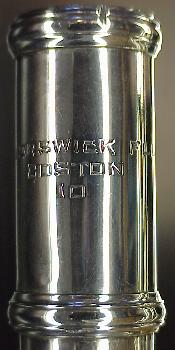 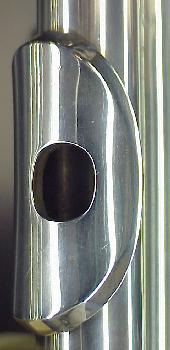
Ashton "Jack" Worswick
|
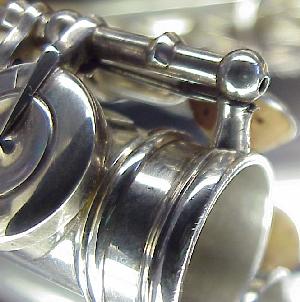 Worswick tried to open his own shop in
1930. Perhaps due in part to the economic hardships of the
great depression, this enterprise must have been
short-lived, as records have him working for
Haynes-Schwelm in 1934, then back with Powell again in
1935. In 1936 Worswick again tried his hand at opening an
independent shop, which once again appears to have failed
quickly since he is listed working for William S. Haynes
in 1937 and for the next few years. The relocation of his
residence to Jamaica Plain several miles southwest of the
peninsula suggest he might then have worked for yet
another major Boston flutemaker, Harry Bettoney. During
WW2 Worswick worked for the war effort as a machinist in
the Boston naval yard. At the war's end he resumed
flutemaking for Wm. S. Haynes Co, where he practiced his
former craft from 1947-1953. Described by
acquaintances as "an elegant man," Ashton died in 1956 at
66 years of age. Worswick tried to open his own shop in
1930. Perhaps due in part to the economic hardships of the
great depression, this enterprise must have been
short-lived, as records have him working for
Haynes-Schwelm in 1934, then back with Powell again in
1935. In 1936 Worswick again tried his hand at opening an
independent shop, which once again appears to have failed
quickly since he is listed working for William S. Haynes
in 1937 and for the next few years. The relocation of his
residence to Jamaica Plain several miles southwest of the
peninsula suggest he might then have worked for yet
another major Boston flutemaker, Harry Bettoney. During
WW2 Worswick worked for the war effort as a machinist in
the Boston naval yard. At the war's end he resumed
flutemaking for Wm. S. Haynes Co, where he practiced his
former craft from 1947-1953. Described by
acquaintances as "an elegant man," Ashton died in 1956 at
66 years of age. |
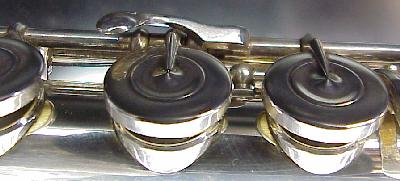 The Worswick Flute/Boston/10 displays the
understated elegance of the best handmade Boston flutes of
the period, perhaps rather more like an early Haynes than
a Powell in mechanism design and finish. Toneholes, points
and posts are fitted and soldered with the care one would
expect from an artisan intent on impressing a potential
clientele in the city which already laid claim to some of
the best flutemakers in the world. The Worswick Flute/Boston/10 displays the
understated elegance of the best handmade Boston flutes of
the period, perhaps rather more like an early Haynes than
a Powell in mechanism design and finish. Toneholes, points
and posts are fitted and soldered with the care one would
expect from an artisan intent on impressing a potential
clientele in the city which already laid claim to some of
the best flutemakers in the world. |
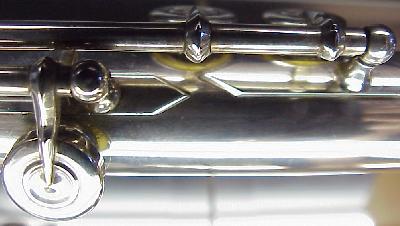 Susan Berdahl ended her narrative on
Ashton Worswick with the statement, "No Worswick Flute
Company flutes are known to exist." At that time
this flute was safely ensconced in the closet of Ed
Ransom. His parents (both graduates of the Art Institute
of Chicago) located this flute in a shop in the Chicago
area in the early 1950's and purchased it for Ed to play
in the 7th grade. Ed was kind enough to pass this bit of
flute history along to me. Solder joins appeared sound,
mechanism sluggish but solid, less worn than many flutes
of similar vintage (perhaps due to its long retirement).
Pads, corks and shims were shot and a hodgepodge of spring
types hint at earlier work done to the flute over the
years. Susan Berdahl ended her narrative on
Ashton Worswick with the statement, "No Worswick Flute
Company flutes are known to exist." At that time
this flute was safely ensconced in the closet of Ed
Ransom. His parents (both graduates of the Art Institute
of Chicago) located this flute in a shop in the Chicago
area in the early 1950's and purchased it for Ed to play
in the 7th grade. Ed was kind enough to pass this bit of
flute history along to me. Solder joins appeared sound,
mechanism sluggish but solid, less worn than many flutes
of similar vintage (perhaps due to its long retirement).
Pads, corks and shims were shot and a hodgepodge of spring
types hint at earlier work done to the flute over the
years. |
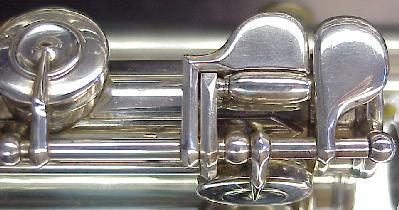 Surprisingly, the only major sign of truly
outrageous fortune is an odd longitudinal dent in the
headjoint that at first appeared to be delamination of a
seamed tube but, extruded tubing being the norm for flutes
of this period, further inspection revealed the obvious.
The damage was no doubt caused by improper and energetic
use of a swab stick, perhaps to adjust the cork placement.
The headjoint nonetheless spoke well when used in a body
in better repair, with a resistance and tonal color not
unlike a very early Powell. Surprisingly, the only major sign of truly
outrageous fortune is an odd longitudinal dent in the
headjoint that at first appeared to be delamination of a
seamed tube but, extruded tubing being the norm for flutes
of this period, further inspection revealed the obvious.
The damage was no doubt caused by improper and energetic
use of a swab stick, perhaps to adjust the cork placement.
The headjoint nonetheless spoke well when used in a body
in better repair, with a resistance and tonal color not
unlike a very early Powell.Following a proper overhaul by Harold Phillips at J. L. Smith & Co., the mech is light and tight without the "fragile" feeling of some older flutes, and the crease in the headjoint has been smoothed down to near invisibility. I agree with Larry Woodall, who performed a similar resurrection on his Worswick #7: "the Worswick flute plays fantastically ... as good or better than any Powell or Brannen." It is a real player with good intonation (if you can stay away from the A=442+ ensembles) and a responsive and strongly centered voice from low C on up into the somewhat reserved third octave. If only Mr. Worswick had picked better economic times to strike out on his own -- and maybe changed his name to something a bit easier to remember -- he might have taken his place among the best of the Boston makers. |
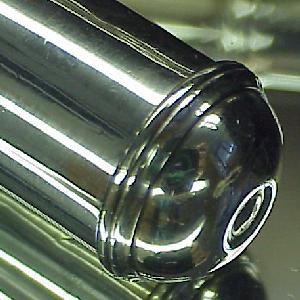 Return to GoferJoe's Flutes
Return to GoferJoe's Flutes Thanks to Ed Ransom and
Susan Berdahl for the lesson in flute history.
Images © J. W.
Sallenger.